1976 Pacific hurricane season
| 1976 Pacific hurricane season | |
|---|---|
|
Season summary map | |
| Seasonal boundaries | |
| First system formed | June 2, 1976 |
| Last system dissipated | October 29, 1976 |
| Strongest storm | |
| Name | Annette |
| • Maximum winds |
140 mph (220 km/h) (1-minute sustained) |
| • Lowest pressure | 925 mbar (hPa; 27.32 inHg) |
| Seasonal statistics | |
| Total depressions | 19 |
| Total storms | 15 |
| Hurricanes | 9 |
| Major hurricanes (Cat. 3+) | 5 |
| Total fatalities | 614-964 |
| Total damage | $360 million (1976 USD) |
| Related articles | |
The 1976 Pacific hurricane season was a very deadly and costly season. Hurricanes Kathleen, Liza, and Madeline were the most notable storms this year. Hurricane Kathleen caused death and destruction in California and Arizona due to flooding. Hurricane Liza was the deadliest storm of the season when it killed over 600 people in Mexico. Hurricane Madeline is notable for being the most intense Pacific hurricane at landfall. Also of note are that the final four systems all made landfall. These storms were (in order): Kathleen, Liza, Madeline and Naomi.
Season summary
The season officially started May 15, 1976, in the eastern Pacific, and June 1, 1976, in the central Pacific, and lasted until November 30, 1976. These dates conventionally delimit the period of each year when most tropical cyclones form in the northeastern Pacific Ocean. In practice, the season lasted from the formation of the first storm on June 2 to the dissipation of the last on October 30.
This season had a slightly below average number of tropical storms, with fourteen. The number of hurricanes was average, with eight. The season had an above-average number of major hurricanes, with five reaching Category 3 or higher on the Saffir-Simpson Hurricane Scale. Four of tropical depressions dissipated before they could reach tropical storm strength. There were five landfalls, including three by consecutive storms.
In the Central Pacific, one tropical cyclone, a hurricane formed. Two storms entered the region from the east. These totals are close to average.[1]

Systems
Tropical Depression One
| Tropical depression (SSHWS) | |
 | |
| Duration | June 2 – June 3 |
|---|---|
| Peak intensity | 35 mph (55 km/h) (1-min) 1006 mbar (hPa) |
Tropical Depression One formed June 2 at a location far out to sea. After moving west, it dissipated the day after it formed.[2]
Hurricane Annette
| Category 4 hurricane (SSHWS) | |
  | |
| Duration | June 3 – June 14 |
|---|---|
| Peak intensity | 140 mph (220 km/h) (1-min) 925 mbar (hPa) |
On June 3, Tropical Depression Two formed from an area of disturbed weather. Three days later, it became a tropical storm and was given the name Annette. It intensified rapidly, reaching Category 4 strength three days later, and its pressure plunged to 925 millibars.[3] Its west-northwest path was well away from any land. Annette dissipated on June 14, without ever affecting land.[2]
Hurricane Bonny
| Category 1 hurricane (SSHWS) | |
  | |
| Duration | June 26 – June 29 |
|---|---|
| Peak intensity | 75 mph (120 km/h) (1-min) 987 mbar (hPa) |
A tropical depression formed on June 26. It intensified into a weak hurricane the next day and headed westward. It then began to weaken. Bonny dissipated June 29, having never threatened land.[2]
Tropical Depression Four
| Tropical depression (SSHWS) | |
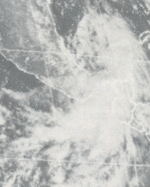 | |
| Duration | June 28 – June 30 |
|---|---|
| Peak intensity | 35 mph (55 km/h) (1-min) 1003 mbar (hPa) |
Tropical Depression Four formed on June 28 from a large area of thunderstorms. Having moved north for its short life, it made landfall near Salina Cruz on June 30 and dissipated shortly after that. Impact was minimal.[2]
Tropical Storm Celeste
| Tropical storm (SSHWS) | |
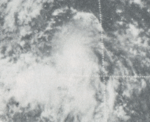  | |
| Duration | July 14 – July 19 |
|---|---|
| Peak intensity | 50 mph (85 km/h) (1-min) |
After a calm of two weeks, Tropical Depression Five formed on July 14. The next day, it reached tropical storm strength. Celeste took a westward track and had no effect on any land area. The storm dropped to a depression on July 17 and dissipated two days later.[2]
Hurricane Diana
| Category 2 hurricane (SSHWS) | |
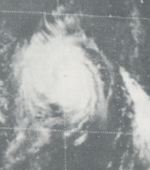  | |
| Duration | July 16 – July 23 |
|---|---|
| Peak intensity | 100 mph (155 km/h) (1-min) |
On July 16, the sixth depression of the season formed. It reached tropical storm strength later that day. The storm continued intensifying, briefly reaching Category 2 strength before weakening as it headed out to sea. Diana dissipated on July 23 not long after entering the Central Pacific Hurricane Center's area of responsibility. Diana's remnants lost their identity shortly after that.[1] Diana did not threaten land.[2]
Tropical Storm Estelle
| Tropical storm (SSHWS) | |
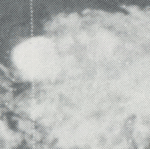  | |
| Duration | July 27 – July 28 |
|---|---|
| Peak intensity | 40 mph (65 km/h) (1-min) 1006 mbar (hPa) |
Part of a large disturbance developed two centers of circulation. One center organized into Tropical Depression Seven on July 27. It quickly strengthened into Tropical Storm Estelle. Due to its proximity to Tropical Storm Fernanda as well as cooler waters, Estelle dissipated on July 29. Its remnants were promptly absorbed by the other system.[2]
Tropical Storm Fernanda
| Tropical storm (SSHWS) | |
  | |
| Duration | July 28 – August 2 |
|---|---|
| Peak intensity | 40 mph (65 km/h) (1-min) 1004 mbar (hPa) |
An active second half of July continued when, on July 28, the other part of the disturbance became Tropical Depression Eight. Soon, the depression was upgraded to Tropical Storm Fernanda. After absorbing the remnants of Tropical Storm Estelle, Fernanda began to weaken.[2] It was only a depression when it entered the CPHC's area of responsibility on July 30. The depression was tracked to a point south of the Hawaiian Islands, and finally dissipated on August 2.[1]
Tropical Storm Gwen
| Tropical storm (SSHWS) | |
  | |
| Duration | August 5 – August 18 |
|---|---|
| Peak intensity | 65 mph (100 km/h) (1-min) 999 mbar (hPa) |
On August 5, a tropical depression formed. Within a day, it was upgraded to tropical storm status and named Gwen. Gwen tracked westward over an area of cooler waters and decelerated. The Eastern Pacific Hurricane Center downgraded Gwen to a depression, as it became nearly stationary on August 11.[2] Hurricane Hyacinth's center then approached within 800 kilometres (500 mi) of Gwen's center. Binary interaction between the two systems (caused by their counter-clockwise circulations) pulled Gwen to the north. Gwen re-intensified to a tropical storm on August 12. It then slowly weakened over cooler waters as Hyacinth fell apart and was absorbed by Gwen.[2] The combined tropical depression headed west and entered the north central Pacific. It was tracked to a point north of Kauai, where it dissipated as a tropical cyclone on August 17. The only effect Gwen had on any land was to disrupt the trade winds enough to cause rainfall on Kauai.[1] After passing north of Hawai'i, thunderstorm activity briefly increased near its center on August 17 and 20. The system recurved to the east of the International Dateline during that time frame. Gwen's remaining low level spin recurved into the Westerlies on August 20.[4]
Hurricane Hyacinth
| Category 3 hurricane (SSHWS) | |
  | |
| Duration | August 6 – August 14 |
|---|---|
| Peak intensity | 115 mph (185 km/h) (1-min) |
Tropical Depression Ten formed on August 6 from an area of disturbed weather. Twelve hours later, it became a tropical storm and was named Hyacinth. Three days later it became a hurricane. Hyacinth rapidly intensified, reaching Category 3 intensity on August 10. It moved over cooler waters and began weakening. After briefly interacting with Tropical Storm Gwen, Hyacinth weakened to a depression and merged with Tropical Depression Gwen on August 14.[2]
Tropical Depression Eleven
| Tropical depression (SSHWS) | |
 | |
| Duration | August 7 – August 8 |
|---|---|
| Peak intensity | 30 mph (45 km/h) (1-min) 1005 mbar (hPa) |
Tropical Depression Eleven formed on August 8. It dissipated the next day as a tropical cyclone after stalling out over the open ocean.[2] Its remnants rotated northwestward around the east and northeast side of the merging Tropical Cyclones Gwen and Hyacinth on August 15.[4]
Tropical Depression Twelve
| Tropical depression (SSHWS) | |
 | |
| Duration | August 16 – August 19 |
|---|---|
| Peak intensity | 35 mph (55 km/h) (1-min) 1006 mbar (hPa) |
Tropical Depression Twelve formed on August 16. After drifting for two days in the open ocean, it moved over cooler waters. It was reduced to a swirl of clouds on August 19.[2]
Hurricane Iva
| Category 4 hurricane (SSHWS) | |
  | |
| Duration | August 24 – September 1 |
|---|---|
| Peak intensity | 130 mph (215 km/h) (1-min) |
The day after forming on the August 24, a tropical depression reached tropical storm intensity. Iva headed west-northwest and intensified to Category 4 on August 29. Iva then weakened and became extratropical on September 2. Except for Socorro Island, Iva never threatened land.[2]
Tropical Storm Joanne
| Tropical storm (SSHWS) | |
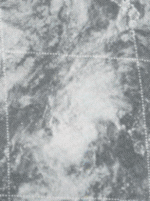  | |
| Duration | August 29 – September 7 |
|---|---|
| Peak intensity | 50 mph (85 km/h) (1-min) |
Tropical Depression Fourteen formed from an area of disturbed weather on August 28. After almost becoming a tropical storm, its circulation collapsed on August 30. Convection and thunderstorms regenerated on August 30. A circulation redeveloped the next day. The depression finally reached tropical storm strength and was named Joanne. An area of clouds degraded Joanne and caused it to dissipate on September 7, having never threatened land.[2]
Hurricane Kathleen
| Category 1 hurricane (SSHWS) | |
  | |
| Duration | September 7 – September 10 |
|---|---|
| Peak intensity | 80 mph (130 km/h) (1-min) 986 mbar (hPa) |
Kathleen was a destructive and costly storm. On September 10 and September 11, it caused millions of dollars in damage and at least four deaths due to widespread flooding in California and Arizona.[5]
Hurricane Kate
| Category 2 hurricane (SSHWS) | |
  | |
| Duration | September 21 – October 2 |
|---|---|
| Peak intensity | 100 mph (155 km/h) (1-min) 971 mbar (hPa) |
The only hurricane to form in the central Pacific arose from a disturbance that drifted in from the east. Tropical Depression Twenty-two formed on September 22. The depression became Tropical Storm Kate the next day.[6] Kate headed almost due northwest. Early on September 24, the storm became a hurricane. This prompted a hurricane watch being issued for the Big Island on September 28. The watch continued until Kate was downgraded to a storm on September 29. It passed 200 miles northwest of the island and was destroyed by wind shear on October 2.[1]
There was only minor damage reported to the northern and eastern shores of Oahu, Maui, and Hawaii due to heavy surf. A ship called the Hawaiian Princess was caught by gales caused by Kate but escaped.[1]
Hurricane Liza
| Category 4 hurricane (SSHWS) | |
_Colored.jpg) 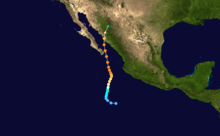 | |
| Duration | September 25 – October 2 |
|---|---|
| Peak intensity | 140 mph (220 km/h) (1-min) 948 mbar (hPa) |
Liza is the third deadliest Eastern Pacific storm of all time, killing 950 people from a dam burst on the Baja Peninsula.[2] Only an unnamed Category 4 hurricane that slammed ashore in 1959, and a tropical depression that later became Hurricane Paul, killed more.[7]
Hurricane Madeline
| Category 4 hurricane (SSHWS) | |
.jpg)  | |
| Duration | September 29 – October 8 |
|---|---|
| Peak intensity | 145 mph (230 km/h) (1-min) 940 mbar (hPa) |
The parade of landfalls continued with Hurricane Madeline. A tropical gale developed into a circulation on September 29 and was named Madeline. The system lost strength almost immediately thereafter. It weakened to a depression and then degenerated into a disturbance.[2]
Five days later, on October 3, the disturbance reformed into a depression and a tropical storm the next day. It reached hurricane strength on October 6 and started recurving to the north. Moving over warm water, Madeline rapidly intensified to a category 4 storm with a peak central pressure of 940 mbar and winds of 145 miles per hour, the highest of the season. Madeline made landfall near Zihuatanejo on October 8 and quickly weakened over Mexico.
Tropical Storm Naomi
| Tropical storm (SSHWS) | |
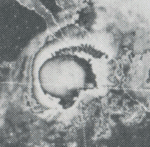  | |
| Duration | October 25 – October 29 |
|---|---|
| Peak intensity | 50 mph (85 km/h) (1-min) ≤ 1004 mbar (hPa) |
After almost two weeks of inactivity, a tropical depression formed on October 25. It quickly strengthened into a tropical storm. Naomi took an unusual east-northeasterly track. Naomi made landfall on October 29, and quickly dissipated the next day. Reported damage was minimal.[2]
Storm names
The following names were used for named storms that formed in the eastern Pacific in 1976. It is the same list used in the 1972 season. No names were retired from this list. However, as modern naming began in 1978, this is the last time this list was used. Names that were not assigned are marked in gray.
|
|
The central Pacific used names and numbers from the western Pacific typhoon name list. Kate was the only name required.
See also
- List of Pacific hurricanes
- List of Pacific hurricane seasons
- 1976 Atlantic hurricane season
- 1976 Pacific typhoon season
- 1976 North Indian Ocean cyclone season
- Southern Hemisphere tropical cyclone seasons: 1975–76, 1976–77
References
- 1 2 3 4 5 6 Central Pacific Hurricane Center archive accessed March 11, 2006
- 1 2 3 4 5 6 7 8 9 10 11 12 13 14 15 16 17 18 Monthly Weather Review accessed March 11, 2006
- ↑ Unisys Weather Archive accessed March 11, 2006
- 1 2 Arthur C. Pike (1977). "Merger of Tropical Cyclone Remnants Over the Northeast Pacific". Satellite Applications Information Note. National Weather Service/National Environmental Satellite Service: 1–2, 6.
- ↑ USA Today: California's tropical storms accessed March 11, 2006
- ↑ Pao-Shin Chu; Peng Wu (2008). Climatic Atlas of Tropical Cyclone Tracks over the Central North Pacific (PDF) (Report). University of Hawaii-Manoa. Retrieved August 2, 2015.
- ↑ USA Today West Mexico Hurricanes accessed March 11, 2006
External links
- Eastern North Pacific Tropical Cyclones of 1976
- CPHC Season Summary
- Unisys Weather archive for the Eastern Pacific, 1976
- ATCR report on Hurricane Kate
